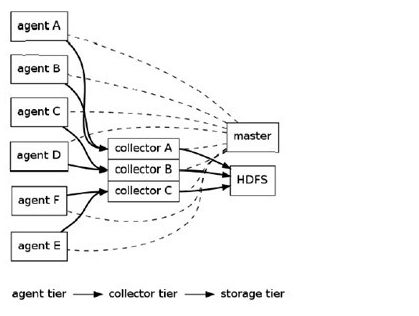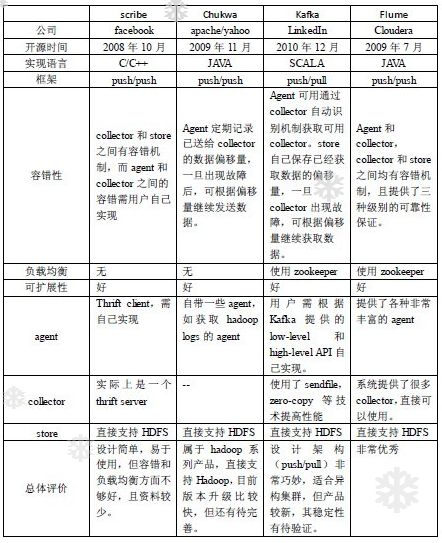Flume日志收集
- 一Flume介绍
- 设计目标
- 二Flume架构
- 1 agent
- 2 collector
- 3storage
- 4Master
- 三Flume分布式环境部署
- 实验场景
- Flume环境安装
- 选择一个或多个节点当做master
- 修改静态配置文件
- 启动集群
一、Flume介绍
Flume是一个分布式、可靠、和高可用的海量日志聚合的系统,支持在系统中定制各类数据发送方,用于收集数据;同时,Flume提供对数据进行简单处理,并写到各种数据接受方(可定制)的能力。
设计目标:
(1) 可靠性
当节点出现故障时,日志能够被传送到其他节点上而不会丢失。Flume提供了三种级别的可靠性保障,从强到弱依次分别为:end-to-end(收到数据agent首先将event写到磁盘上,当数据传送成功后,再删除;如果数据发送失败,可以重新发送。),Store on failure(这也是scribe采用的策略,当数据接收方crash时,将数据写到本地,待恢复后,继续发送),Best effort(数据发送到接收方后,不会进行确认)。
(2) 可扩展性
Flume采用了三层架构,分别为agent,collector和storage,每一层均可以水平扩展。其中,所有agent和collector由master统一管理,这使得系统容易监控和维护,且master允许有多个(使用ZooKeeper进行管理和负载均衡),这就避免了单点故障问题。
(3) 可管理性
所有agent和colletor由master统一管理,这使得系统便于维护。多master情况,Flume利用ZooKeeper和gossip,保证动态配置数据的一致性。用户可以在master上查看各个数据源或者数据流执行情况,且可以对各个数据源配置和动态加载。Flume提供了web 和shell script command两种形式对数据流进行管理。
(4) 功能可扩展性
用户可以根据需要添加自己的agent,collector或者storage。此外,Flume自带了很多组件,包括各种agent(file, syslog等),collector和storage(file,HDFS等)。
二、Flume架构
flume的逻辑架构:
正如前面提到的,Flume采用了分层架构:分别为agent,collector和storage。其中,agent和collector均由两部分组成:source和sink,source是数据来源,sink是数据去向。
Flume使用两个组件:Master和Node,Node根据在Master shell或web中动态配置,决定其是作为Agent还是Collector。
(1) agent
agent的作用是将数据源的数据发送给collector。
Flume自带了很多直接可用的数据源(source),如:
- text(“filename”):将文件filename作为数据源,按行发送
- tail(“filename”):探测filename新产生的数据,按行发送出去
- fsyslogTcp(5140):监听TCP的5140端口,并且接收到的数据发送出去
- tailDir("dirname"[, fileregex=".*"[, startFromEnd=false[, recurseDepth=0]]]):监听目录中的文件末尾,使用正则去选定需要监听的文件(不包含目录),recurseDepth为递归监听其下子目录的深度
更多可参见这位朋友的整理:http://www.cnblogs.com/zhangmiao-chp/archive/2011/05/18/2050465.html
同时提供了很多sink,如:
- console[("format")] :直接将将数据显示在consolr上
- text(“txtfile”):将数据写到文件txtfile中
- dfs(“dfsfile”):将数据写到HDFS上的dfsfile文件中
- syslogTcp(“host”,port):将数据通过TCP传递给host节点
- agentSink[("machine"[,port])]:等价于agentE2ESink,如果省略,machine参数,默认使用flume.collector.event.host与flume.collector.event.port作为默认collecotr
- agentDFOSink[("machine" [,port])]:本地热备agent,agent发现collector节点故障后,不断检查collector的存活状态以便重新发送event,在此间产生的数据将缓存到本地磁盘中
- agentBESink[("machine"[,port])]:不负责的agent,如果collector故障,将不做任何处理,它发送的数据也将被直接丢弃
- agentE2EChain:指定多个collector提高可用性。 当向主collector发送event失效后,转向第二个collector发送,当所有的collector失败后,它会非常执着的再来一遍
更多可参见这位朋友的整理:http://www.cnblogs.com/zhangmiao-chp/archive/2011/05/18/2050472.html
(2) collector
collector的作用是将多个agent的数据汇总后,加载到storage中。
它的source和sink与agent类似。
数据源(source),如:
- collectorSource[(port)]:Collector source,监听端口汇聚数据
- autoCollectorSource:通过master协调物理节点自动汇聚数据
- logicalSource:逻辑source,由master分配端口并监听rpcSink
sink,如:
- collectorSink( "fsdir","fsfileprefix",rollmillis):collectorSink,数据通过collector汇聚之后发送到hdfs, fsdir 是hdfs目录,fsfileprefix为文件前缀码
- customdfs("hdfspath"[, "format"]):自定义格式dfs
(3) storage
storage是存储系统,可以是一个普通file,也可以是HDFS,HIVE,HBase,分布式存储等。
(4) Master
Master是管理协调agent和collector的配置等信息,是flume集群的控制器。
在Flume中,最重要的抽象是data flow(数据流),data flow描述了数据从产生,传输、处理并最终写入目标的一条路径。

- 对于agent数据流配置就是从哪得到数据,把数据发送到哪个collector。
- 对于collector是接收agent发过来的数据,把数据发送到指定的目标机器上。
注:Flume框架对hadoop和zookeeper的依赖只是在jar包上,并不要求flume启动时必须将hadoop和zookeeper服务也启动。
三、Flume分布式环境部署
1.实验场景
- 操作系统版本:RedHat 5.6
- Hadoop版本:0.20.2
- Jdk版本:jdk1.6.0_26
- 安装flume版本:flume-distribution-0.9.4-bin
部署flume在集群上,按照如下步骤:
- 在集群上的每台机器上安装flume
- 选择一个或多个节点当做master
- 修改静态配置文件
- 在至少一台机器上启动一个master ,所有节点启动flume node
- 动态配置
需要在集群的每台机器上部署Flume。
注意:flume集群整个集群的网络环境要保证稳定,可靠,否则会出现一些莫名错误(比如:agent端发送不了数据到collector)。
1.Flume环境安装
$wget http://cloud.github.com/downloads/cloudera/flume/flume-distribution-0.9.4-bin.tar.gz $tar -xzvf flume-distribution-0.9.4-bin.tar.gz $cp -rf flume-distribution-0.9.4-bin /usr/local/flume $vi /etc/profile #添加环境配置 export FLUME_HOME=/usr/local/flume export PATH=.:$PATH::$FLUME_HOME/bin $source /etc/profile $flume #验证安装
2.选择一个或多个节点当做master
对于master的选择情况,可以在集群上定义一个master,也可以为了提高可用性选择多个节点做为master。
- 单点master模式:容易管理,但在系统的容错和扩展性有缺陷
- 多点master模式:通常是运行3/5个master,能很好的容错
Flume master数量的选择原则:
分布式的master能够继续正常工作不会崩溃的前提是正常工作的master数量超过总master数量的一半。
Flume master 的作用主要有两个:
- 跟踪各节点的配置情况,通知节点配置的改变;
- 跟踪来自flow的结尾操控在可靠模式下(E2E)的信息,以至于让flow的源头知道什么时候停止传输event。
3.修改静态配置文件
site-specific设置对于flume节点和master通过在每一个集群节点的conf/flume-site.xml是可配置的,如果这个文件不存在,设置的属性默认的在conf/flume-conf.xml中,在接下来的例子中,在flume的节点上设置master名,让节点自己去寻找叫“master”的flume Master。
<?xml version="1.0"?> <?xml-stylesheet type="text/xsl" href="configuration.xsl"?> <configuration> <property> <name>flume.master.servers</name> <value>master</value> </property> </configuration>
在多master的情况下需要如下配置:
<property> <name>flume.master.servers</name> <value>hadoopmaster.com,hadoopedge.com,datanode4.com</value> <description>A comma-separated list of hostnames, one for each machine in the Flume Master.</description> </property> <property> <name>flume.master.store</name> <value>zookeeper</value> <description>How the Flume Master stores node configurations. Must be either 'zookeeper' or 'memory'.</description> </property> <property> <name>flume.master.serverid</name> <value>2</value> <description>The unique identifier for a machine in a Flume Master ensemble. Must be different on every master instance.</description> </property>
注意:flume.master.serverid 属性的配置主要是针对master,集群上Master节点的flume.master.serverid 必须是不能相同的,该属性的值以0开始。
当使用agent角色时,你可以通过添加下面的配置文件在flume-conf.xml中,来设置默认的collector主机:
<property> <name>flume.collector.event.host</name> <value>collector</value> <description>This is the host name of the default "remote" collector.</description> </property> <property> <name>flume.collector.port</name> <value>35853</value> <description>This default tcp port that the collector listens to in order to receive events it is collecting.</description> </property>
关于配置可参见:http://www.cnblogs.com/zhangmiao-chp/archive/2011/05/18/2050443.html。
4.启动集群
集群上节点启动:
- 在命令行输入:flume master 启动master节点
- 在命令行输入:flume node –n nodeName 启动其他节点,nodeName最好根据集群逻辑的划分来取名子,这样在 master进行配置的时候比较清晰。
名字规则自己定义,方便记忆和动态配置即可(后续会有介绍动态配置)
转载自:http://www.cnblogs.com/Leo_wl/archive/2012/05/25/2518716.html
http://www.cnblogs.com/oubo/archive/2012/05/25/2517751.html

